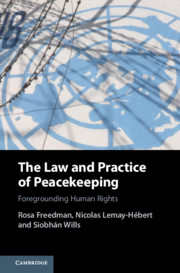Book contents
- The Law and Practice of Peacekeeping
- The Law and Practice of Peacekeeping
- Copyright page
- Contents
- 1 Introduction
- 2 A Political History of UN Involvement in Haiti
- 3 Integrating Human Rights Norms into UN Peacekeeping Practice
- 4 UN Immunities and Human Rights
- 5 The Cholera Epidemic
- 6 Sexual Exploitation and Abuse
- 7 UN Peacekeepers’ Use of Deadly Force to Maintain Law and Order
- 8 Conclusion
- Index
7 - UN Peacekeepers’ Use of Deadly Force to Maintain Law and Order
Published online by Cambridge University Press: 28 May 2021
- The Law and Practice of Peacekeeping
- The Law and Practice of Peacekeeping
- Copyright page
- Contents
- 1 Introduction
- 2 A Political History of UN Involvement in Haiti
- 3 Integrating Human Rights Norms into UN Peacekeeping Practice
- 4 UN Immunities and Human Rights
- 5 The Cholera Epidemic
- 6 Sexual Exploitation and Abuse
- 7 UN Peacekeepers’ Use of Deadly Force to Maintain Law and Order
- 8 Conclusion
- Index
Summary
This chapter examines the use of deadly force by UN peacekeepers mandated under Chapter VII of the UN Charter but operating outside the context of hostilities. Such actions may occur, for example when peacekeepers are deployed to a country where there is no armed conflict or when they are conducting operations against persons or groups who do not belong to the armed forces of a party to an armed conflict. The chapter will draw on the practice of the UN Stabilization Mission in Haiti (MINUSTAH), deployed from June 2004 to October 2017, during which time there was no armed conflict as defined in international law in Haiti.
- Type
- Chapter
- Information
- The Law and Practice of PeacekeepingForegrounding Human Rights, pp. 116 - 139Publisher: Cambridge University PressPrint publication year: 2021
- 1
- Cited by

